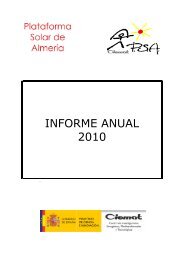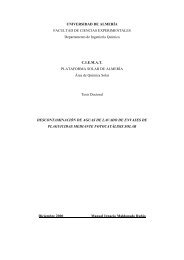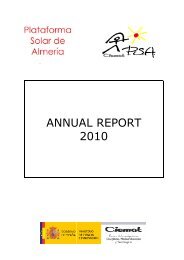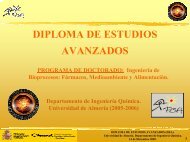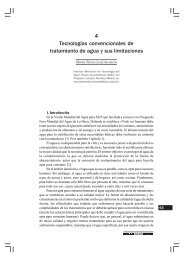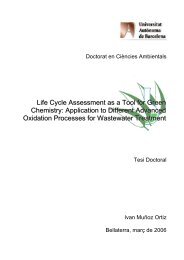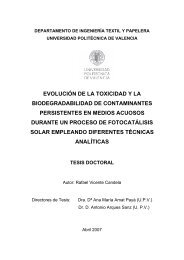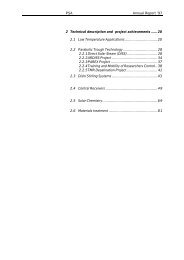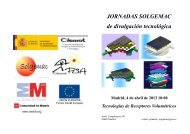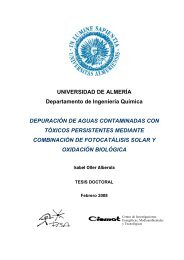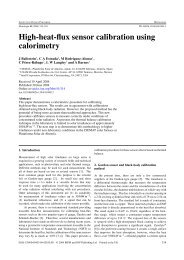Annual Report 2006 - Plataforma Solar de AlmerÃa
Annual Report 2006 - Plataforma Solar de AlmerÃa
Annual Report 2006 - Plataforma Solar de AlmerÃa
Create successful ePaper yourself
Turn your PDF publications into a flip-book with our unique Google optimized e-Paper software.
ENVIRONMENTAL APPLICATIONS OF SOLAR ENERGY<br />
4.3 Gas Phase Detoxification Group<br />
The main objective of this group is the <strong>de</strong>velopment of efficient systems for<br />
the treatment of polluted air streams using preferentially solar radiation as<br />
energy source. Although adsorbents and combustion catalysts have been also<br />
used for this purpose, the group activities are focused on the <strong>de</strong>velopment of<br />
photocatalytic processes for air purification. In this way, the <strong>de</strong>sign of most<br />
efficient supported photocatalyst constitutes one of the major priorities of this<br />
research. Regarding the nature of the pollutants a significant effort has been<br />
<strong>de</strong>voted to the abatement of volatile organic compounds (VOCs) and inorganic<br />
molecules toxic and malodorous like H 2 S, but the inactivation of airborne microorganisms<br />
is also approached. Therefore, the results obtained in these investigations<br />
are aimed to provi<strong>de</strong> solutions for the problems of both industrial<br />
and workshops emissions and the indoor air quality.<br />
4.3.1 Development of alternative preparation methods for<br />
high-efficiency photocatalytic materials<br />
Participants: CIEMAT (PSA-DER) and ICP-CSIC (Spain).<br />
Contact:<br />
Funding:<br />
Dr. B. Sánchez; benigno.sanchez@ciemat.es<br />
MCYT Spanish Ministry of Science and Technology. Total project<br />
funding: 75 k€ (Jan. 2005 – Dec. 2007).<br />
Background: Gas treatment requires photocatalysts fixed on a substrate<br />
shaped as open structures, which allow treating high flow rates without dragging<br />
the photoactive components. In addition, the support should be transparent<br />
to the UVA radiation used for activation of the photocatalyst in or<strong>de</strong>r to<br />
make the most effective use of inci<strong>de</strong>nt photons. However, available photocatalysts<br />
do not fulfill all these requirements.<br />
Purpose: The aim of this project is to satisfy the growing <strong>de</strong>mand for versatile<br />
high-activity supported photocatalysts for the efficient elimination of air pollutants<br />
like Volatile Organic Compounds (VOCs). Novel TiO 2 -film photocatalysts<br />
(formed by anatase or anatase-rutile mixtures), and other semiconductors<br />
such as SnO 2 or ZrO 2 and noble metals will be supported on substrates<br />
different compositions and morphologies (ceramic, metallic, polymeric).<br />
TiO 2 will be synthesized by a sol-gel procedure which guaranties lowtemperature<br />
formation of anatase nuclei, and consequently, at a temperature<br />
Figure 4.11 Some examples of the supports used to <strong>de</strong>posit TiO 2 on A) borosilicate<br />
glass tubes; B) polymeric monoliths<br />
85



